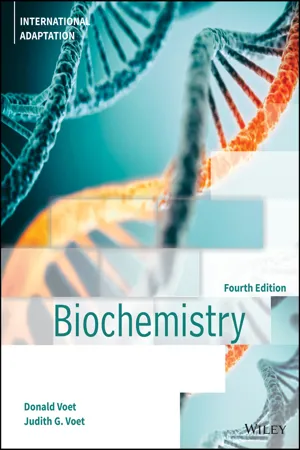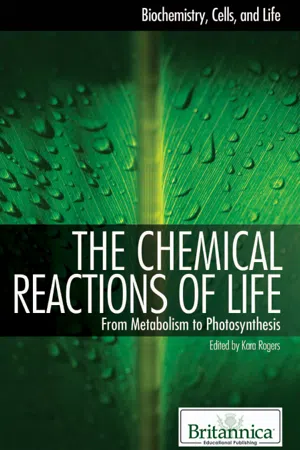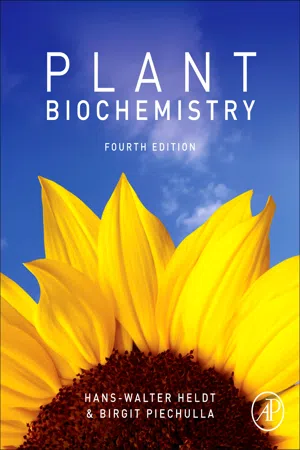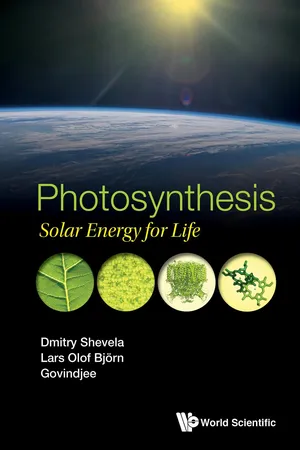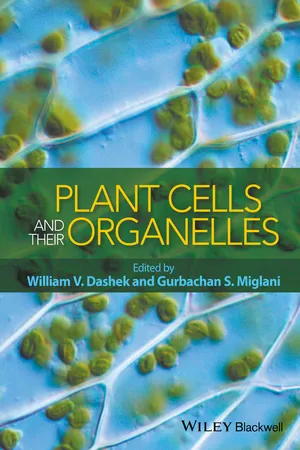Biological Sciences
Investigating Photosynthesis
"Investigating Photosynthesis" involves studying the process by which plants, algae, and some bacteria convert light energy into chemical energy to produce glucose and oxygen. Researchers explore the factors that affect photosynthesis, such as light intensity, carbon dioxide levels, and temperature, to understand its mechanisms and optimize plant growth. This research is crucial for improving agricultural practices and addressing environmental challenges.
Written by Perlego with AI-assistance
Related key terms
Related key terms
1 of 4
Related key terms
1 of 3
8 Key excerpts on "Investigating Photosynthesis"
- eBook - ePub
- Donald Voet, Judith G. Voet(Authors)
- 2021(Publication Date)
- Wiley(Publisher)
21 Photosynthesis: Bioinorganic Chemistry and Physiology1 Chloroplasts2 Light ReactionsA. Absorption of LightB. Electron Transport in Purple Photosynthetic BacteriaC. Two-Center Electron TransportD. Photophosphorylation3 Dark ReactionsA. The Calvin CycleB. Control of the Calvin CycleC. Photorespiration and the C4 CycleLife on Earth depends on the sun. Plants and cyanobacteria chemically sequester light energy through photosynthesis, a light-driven process in which CO2 is “fixed” to yield carbohydrates (CH2 O).This process, in which CO2 is reduced and H2 O is oxidized to yield carbohydrates and O2 , is essentially the reverse of oxidative carbohydrate metabolism. Photosynthetically produced carbohydrates therefore serve as an energy source for the organism that produced them as well as for nonphotosynthetic organisms that directly or indirectly consume photosynthetic organisms. In fact, even modern industry is highly dependent on the products of photosynthesis because coal, oil, and gas (the so-called fossil fuels) are thought to be the remains of ancient organisms. It is estimated that photosynthesis annually fixes ∼1011 tons of carbon, which represents the storage of over 1018 kJ of energy. Moreover, photosynthesis, over the eons, has produced the O2 in Earth's atmosphere (Section 1-1C ).The notion that plants obtain nourishment from such insubstantial things as light and air took nearly two centuries to develop. In 1648, the Flemish physician Jean Baptiste van Helmont reported that growing a potted willow tree from a shoot caused an insignificant change in the weight of the soil in which the tree had been rooted. Although another century was to pass before the law of conservation of matter was formulated, van Helmont attributed the tree's weight gain to the water it had taken up. This idea was extended in 1727 by Stephen Hales, who proposed that plants extract some of their matter from the air. - eBook - ePub
Sugarcane
Agricultural Production, Bioenergy and Ethanol
- Fernando Santos, Aluízio Borém, Celso Caldas(Authors)
- 2015(Publication Date)
- Academic Press(Publisher)
This chapter aims to present briefly the main physiological processes responsible for crop growth and development and to show how they are involved in the metabolic processes of the main compounds responsible for sugarcane products commercially exploited. The study of plant physiology covers a much wider field than we will cover, ranging from the expression of specific genes to complex metabolic processes; this would require further studies. We will briefly detail the procedures for obtaining and assimilating carbon and the synthesis of sucrose, which is the main compound of interest in Agronomics currently. Additionally we will circumstantially present the processes of plant growth and development, with emphasis on the two physiological stages of great agricultural importance: flowering and maturation.2.1 Photosynthesis
The photosynthetic apparatus is located in the chloroplasts, specifically in specialized membranes called thylakoids. These membrane-bound structures are found in high-density – grana thylakoid – and low-density – stroma thylakoid (also called intergrana thylakoids or lamellae) – and are composed of an external matrix, the stroma, and an internal matrix, the lumen. Photosynthesis takes place in the thylakoids because of the presence of photosynthetic pigments, i.e., chlorophylls, which absorb light in the range of 400–700 nm. This spectrum band, which is used by plants as a source of energy for their metabolic activities, is commonly identified as Photosynthetically Active Radiation (PAR), the unit for which is μmol of photons/m2 /s.The photosynthetic process can be represented by a simplified equation of reduction in which CO2 receives electrons and CH is reduced. The H2 O is oxidized, releasing O2 , since light promotes the oxidation of water:12H 2O + 6CO 2→light + chlorophyllC 6H 12O 6+ 6H 2O + 6O 2Photosynthesis refers to a series of reactions, which involves light absorption, energy conversion, electron transfer and multiple processes. Enzymes are involved in these processes converting CO2 - Olen R. Brown(Author)
- 2017(Publication Date)
- Bentham Science Publishers(Publisher)
2 ] revealed that the mechanism of this biological energy-capture requires utilization of quantum mechanics for photosynthesis in certain bacteria (and probably in all systems). They found evidence of “quantum entanglements” that persist over picoseconds in this complex biological system, helping to account for its efficiency. If particles, such as two electrons in this case, are “entangled” any change in one is instantly reflected in the other. Their results were interpreted to indicate that photons exhibit this property in the bacterial light-harvesting complex. They suggested that this has implications for future attempts to design quantum-based technologies for computing. It is currently being used to create hybrid photosynthetic machines.Thus, carbon dioxide, a single atom of carbon oxidized by two atoms of oxygen from the atmosphere where it is present at a concentration only two thousands that of oxygen, via the miracle of photosynthesis, creates the carbon backbone underpinning life on earth.Measuring Global Photosynthesis
Assessing the global rate of photosynthesis is important but complex and technically difficult. A leap forward in ability to assess global photosynthesis was made possible by satellites. Understanding this involves exploring how photosynthesis works.To thrive and grow all plants photosynthesize using chlorophyll, a complex molecule that gives the green color to plant life. The word photosynthesis implies conversion of the energy of sunlight into the chemical energy in the bonds of organic compounds that are usable by plant cells (Fig. 1 ). Chlorophyll absorbs light from most of the visible spectrum, except for the green wavelengths which are reflected and this accounts for our perception that leaves are green.Fig. (1)) Measuring photosynthesis from space using sensors on satellites. Image credit: NASA Goddard’s Conceptual Image Lab/T. Chase.Measuring the extent of photosynthesis is necessary for understanding atmospheric carbon dioxide concentrations but it also is a surrogate for assessing the degree to which plants are thriving. Plants that are healthy and which have adequate nutrients and water photosynthesize abundantly by absorbing sunlight and releasing some energy as fluorescence. Thus, the extent of fluorescence indicates the extent of photosynthesis. Fig. (1 ) diagrammatically shows that light is absorbed by chlorophyll-containing green structures within a plant and some is re-emitted as fluorescence. Healthy plants exhibit high fluorescence while low or no fluorescence is indicative of plants that are stressed by temperature, lack of water, disease or inadequate sunlight, as examples. This fluorescence, associated with events occurring inside plants at a cellular level, has been detected and measured from a great distance away, over large geographic areas, by using satellite imaging [3 ]. The fluorescence is invisible to the human eye, but is detectable by instruments on satellites orbiting hundreds of miles above Earth. NASA scientists have developed a way to convert this satellite data into global maps that allow photosynthesis over a broad land area to be estimated in considerable detail [3 ]. The satellite maps permit assessment of plant health and also allow estimation of photosynthesis rates by regions and also globally [3- eBook - ePub
The Chemical Reactions of Life
From Metabolism to Photosynthesis
- Britannica Educational Publishing, Kara Rogers(Authors)
- 2010(Publication Date)
- Britannica Educational Publishing(Publisher)
The actual percentage of solar energy stored by plants is much less than the maximum energy efficiency of photosynthesis. An agricultural crop in which the biomass (total dry weight) stores as much as 1 percent of total solar energy received on an annual area-wide basis is exceptional, although a few cases of higher yields (perhaps as much as 3.5 percent in sugarcane) are reported. There are several reasons for this difference between the predicted maximum efficiency of photosynthesis and the actual energy stored in biomass. First, more than half of the incident sunlight is composed of wavelengths too long to be absorbed, while some of the remainder is reflected or lost to the leaves. Consequently, plants can at best absorb only about 34 percent of the incident sunlight. Second, plants must carry out a variety of physiological processes in such nonphotosynthetic tissues as roots and stems. These processes, as well as cellular respiration in all parts of the plant, use up stored energy. Third, rates of photosynthesis in bright sunlight sometimes exceed the needs of the plants, resulting in the formation of excess sugars and starch. When this happens, the regulatory mechanisms of the plant slow down the process of photosynthesis, allowing more absorbed sunlight to go unused. Fourth, in many plants, energy is wasted by the process of photorespiration. Finally, the growing season may last only a few months of the year. Sunlight received during other seasons is not used. Furthermore, it should be noted that if only agricultural products (e.g., seeds, fruits, and tubers, rather than total biomass) are considered as the end product of the energy conversion process of photosynthesis, the efficiency falls even further.Sunflowers, like the ones shown here in Zehlendorf, Germany, are an important food crop. Their seeds, used for snacks and vegetable oil, are examples of the end products of photosynthesis . Michael Urban/AFP/Getty ImagesCHLOROPLASTS, THE PHOTOSYNTHETIC UNITS OF GREEN PLANTS
The process of plant photosynthesis takes place entirely within the chloroplasts. Detailed studies of the role of these organelles date from the work of the British biochemist Robert Hill. About 1940 Hill discovered that green particles obtained from broken cells could produce oxygen from water in the presence of light and a chemical compound, such as ferric oxalate, able to serve as an electron acceptor. This process is known as the Hill reaction. During the 1950s Daniel Arnon and other American biochemists prepared plant cell fragments in which not only the Hill reaction but also the synthesis of the energy-storage compound ATP occurred. In addition, the coenzyme NADP was used as the final acceptor of electrons, replacing the nonphysiological electron acceptors used by Hill. His procedures were refined further so that individual small pieces of isolated chloroplast membranes, or lamellae, could perform the Hill reaction. These small pieces of lamellae were then fragmented into pieces so small that they performed only the light reactions of the photosynthetic process. It is now possible also to isolate the entire chloroplast so that it can carry out the complete process of photosynthesis, from light absorption, oxygen formation, and the reduction of carbon dioxide to the formation of glucose and other products. - eBook - ePub
Biology
A Self-Teaching Guide
- Steven D. Garber(Author)
- 2020(Publication Date)
- Jossey-Bass(Publisher)
6 PhotosynthesisEvery leaf is essentially a solar-powered carbohydrate factory where, fueled by the sun, raw materials such as carbon dioxide and water are transformed by the complex molecular machinery into stable, energy-rich, finished products that help run nature's entire economy. This solar-powered process that makes carbohydrates is known as photosynthesis. It occurs in the leaves of higher plants, as well as in many other plant parts, especially in those that are green. Photosynthesis also occurs in a range of organisms other than higher plants, including algae and some bacteria and protists.HISTORY
In 1772, Joseph Priestley, a British clergyman and chemist, demonstrated that when a plant or animal was kept alone in an airtight jar, it died. However, when a plant and an animal were put together in an airtight jar, both lived. Seven years later, the Dutch physician Jan Ingen-Housz showed that sunlight was necessary for plants to produce oxygen, although, like Priestley, he knew nothing about oxygen at the time and explained his results in another way. Then in 1782, a Swiss pastor and part-time scientist, Jean Senebier, showed that plants use carbon dioxide (CO2 ) when they produce oxygen (O2 ). He suggested that CO2 was converted to O2 during photosynthesis.Again, it should be stressed that Senebier didn't know which gases were involved. Rather, he reported that the process was dependent upon a particular kind of gas, which he called “fixed air,” and which we now know as carbon dioxide. Then in 1804, the Swiss worker Nicolas-Théodore de Saussure found that water is necessary for the photosynthetic production of organic materials. So by the early nineteenth century, the basic ingredients involved in photosynthesis were already known and could be put in the following equation (see also Figure 6.1 ).In 1883, T.W. Engelmann - eBook - ePub
- Hans-Walter Heldt, Birgit Piechulla(Authors)
- 2010(Publication Date)
- Academic Press(Publisher)
2 The use of energy from sunlight by photosynthesis is the basis of life on earthPlants and cyanobacteria capture the light of the sun and utilize its energy to synthesize organic compounds from inorganic substances such as CO2 , nitrate, and sulfate to synthesize their cellular material; they are photoautotrophic. In photosynthesis photon energy splits water into oxygen and hydrogen, the latter bound as NADPH. This process, termed the light reaction , takes place in the photosynthetic reaction centers embedded in membranes. It involves the transport of electrons, which is coupled to the synthesis of ATP. NADPH and ATP are consumed in a so-called dark reaction to synthesize carbohydrates from CO2 (Fig. 2.1 ). The photosynthesis of plants and cyanobacteria created the biomass on earth, including the deposits of fossil fuels and atmospheric oxygen. Animals are dependent on the supply of carbohydrates and other organic compounds as food; they are heterotrophic. They generate the energy required for their life processes by oxidizing the biomass, which has first been produced by plants. When oxygen is consumed, CO2 is formed. Thus light energy captured by plants is the source of energy for the life processes of animals.Figure 2.1 Life on earth involves a CO2 cycle.2.1 How did photosynthesis start?Measurements of the distribution of radioisotopes led to the conclusion that the earth was formed about 4.6 billion years ago. The earliest indicators of life on earth are fossils of bacteria-like structures, estimated to be 3.5 billion years old. There was no oxygen in the atmosphere when life on earth commenced. This is concluded from the fact that in very early sediment rocks iron is present as Fe2+ . Mineral iron is oxidized to Fe3+ - eBook - ePub
Photosynthesis
Solar Energy for Life
- Dmitry Shevela, Lars Olof Björn, Govindjee(Authors)
- 2018(Publication Date)
- WSPC(Publisher)
Chapter 3
Basics of Photosynthesis: Light-Dependent Reactions
3.1Overview: Harvesting Sunlight to Drive Redox Chemistry
In all photosynthetic organisms (both oxygenic and anoxygenic) the photosynthetic light reactions begin with the absorption of light (photons) by pigments in light-harvesting complexes, embedded in the thylakoid membrane (or in case of cyanobacteria, also in phycobilisomes). The antenna (both outer and inner) systems deliver the energy of absorbed light (excitation energy; we shall discuss it in Section 3.2 ) to pigment–protein reaction center complexes, Photosystems II and I (PSII and PSI; see Section 3.3 ), both embedded in the thylakoid membrane (Fig. 3.1 ). As a consequence of primary photochemistry, which takes place after trapping of the excitation energy by special photoactive chlorophyll (Chl) molecules in the reaction centers of the two photosystems, light energy is converted into chemical energy. This energy drives the redox chemistry of the stepwise linear electron “transfer” from water to the oxidized form of nicotinamide adenine dinucleotide phosphate (NADP+ ), involving PSII and PSI as well as the Cytb6 fcomplex (Fig. 3.1 ). In this chapter we shall also briefly describe photosynthetic ATP production by ATP synthase from ADP and inorganic phosphate (see Section 3.3.3 ).3.2Capturing the Energy of Light
The first step in photosynthesis is the absorption of light by pigment molecules which include Chla, other Chls, or phycobilins, or fucoxanthol, depending on the organism; this step occurs within femtoseconds (one femtosecond is 10−15 s; there are as many femtoseconds in a second as there are seconds in 31.54 million years!). This event means that a photon disappears, and the energy of the molecule increases, the pigment molecule is in an excited state. We need to consider only two kinds of energy of the molecule here: the electronic energy and the vibrational energy, and both are changed when the photon is absorbed, as a consequence of the so-calledFranck-Condon principle: Upon absorption of a photon, the electronic transition from the ground state to the excited state occurs without a change in the position of the nuclei, because “the electrons are light and the nuclei are heavy,” and the molecule goes to a higher vibrational state (see Fig. 3.2 , and the discussion that follows; for Franck-Condon principle, see Rabinowitch and Govindjee [1969], and Atkins and Friedman [1999]). In addition, we have “vibronic” energy, which is a combination of “vibrational” and “electronic” energy: the “vibronic energy coupling” refers to the interaction between electronic and nuclear vibrational energy. This interaction, indeed, makes the light harvesting more efficient in several cases [Deanet al. - eBook - ePub
- William V. Dashek, Gurbachan S. Miglani(Authors)
- 2016(Publication Date)
- Wiley(Publisher)
The energy used to drive this reaction is provided by the absorption of light. The molecular apparatus that performs this process—photosynthesis—is located in thylakoid (from the Greek, “sac‐like”) membranes, which are confined within the chloroplast in plants. Photosynthesis is driven by absorption of light energy by chlorophyll (Chl). Wavelengths of light that contain levels of energy that can be accommodated by the electronic structure of Chl, primarily in the blue and red regions of the visible spectrum (photons with energy levels around 280 and 170 kJ/mol, respectively), are absorbed and generate “excited” states of Chl. The photosynthetic apparatus is designed to collect these packets of light energy and convert them to chemical compounds with sufficiently high levels of energy to drive synthesis of glucose from CO 2 and H 2 O. The major metabolically available end products that are stored in plants are starch, a polymeric form of glucose, or sucrose, a disaccharide. Another polymer of glucose is cellulose, which is metabolically available to several microorganisms but not to animals. Cellulose is used as a structural component by plants. Expanded descriptions of various aspects of photosynthesis can be found in Raghavendra (1998), Blankenship (2002), Wise and Hoober (2006), and Rebeiz et al. (2010). Evolution of photosynthesis Synthesis of tetrapyrroles Photosynthesis is nearly as old as life itself. Measurements of the carbon isotope content in early fossils suggest that a reaction similar to that catalyzed by the enzyme ribulose 1,5‐bisphosphate carboxylase/oxygenase (Rubisco) fixed CO 2 into organic material. Because this reaction involves CO 2 as a reactant, CO 2 molecules containing the heavier isotopes of carbon, i.e., 13 C and 14 C, react slightly more slowly than 12 CO 2. Thus, direct incorporation of CO 2 into organic molecules, which depends upon diffusion, discriminates against the heavier isotopes
Index pages curate the most relevant extracts from our library of academic textbooks. They’ve been created using an in-house natural language model (NLM), each adding context and meaning to key research topics.
Explore more topic indexes
Explore more topic indexes
1 of 6
Explore more topic indexes
1 of 4
